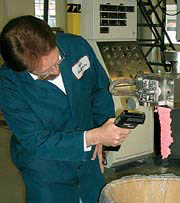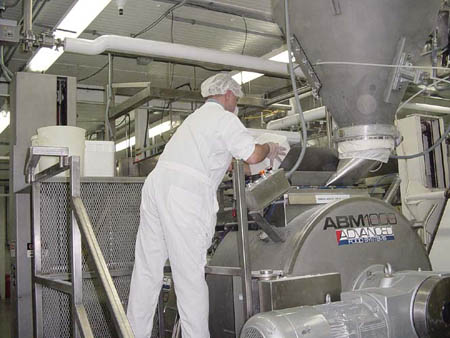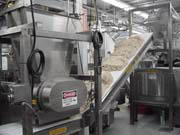
“There was a football-field sized area of half-liter shakers to emulate the motions of researchers who used to shake test tubes of those organisms to start growth,” recalls Calabrese, a professor of chemical engineering at the University of Maryland in College Park. “They had to use all those shakers to produce the quantities they needed because, if they tried to do it in a 50-gallon batch, they couldn’t recreate the kind of mixing that occurred when someone shook a vial by hand.”
Understanding the dynamics of mixing is more than passing interest for Calabrese. As director of the university’s High Shear Mixing Research Program, he is applying Laser Doppler Anemometry (LDA), computational fluid dynamics (CFD) and other analytic tools to better understand how a powder, liquid or combination of the two behave inside a rotor-stator mixing device. The program isn’t academic: it is funded and advised by a board that includes mixer manufacturers and industrial firms such as DuPont and Procter & Gamble who are using the data to redesign their equipment and better predict and control their processing outcomes.
Decades of experience take a lot of the uncertainty out the equation with stirred vessels and static mixers. Rotor-stator devices, on the other hand, have much shorter track records, and that can mean long learning curves and painful trial and error for new products when processors use these high-shear, in-line mixing devices. New formulations involving different ingredients further complicate process optimization. “If you don’t know what the energy fields are like at different points in the process or how the flow field is going to change as you scale up to bigger patches, it’s hard to get the consistent results you want,” notes Calabrese. The consortium’s goal is to bring theoretical tools to bear in predicting those outcomes.
With LDA, an intersection of two laser beams is created with coherent light, forming a parallel plane of measuring volume. When particles cross the measuring volume, the scattered light creates a signal. The light contains a Doppler frequency that provides information about flow velocity. The technology has been around for three decades, but “this is the first time LDA has been used in a study of high-shear mixers,” according to Calabrese. By understanding the energy fields created in a high-shear mixer, engineers can accurately predict the amount of shear created. Application of CFD helps validate LDA findings and flag questionable findings.
“This work is providing power-drop data that was unavailable until now and is very useful in understanding the fundamental functions inside a mixer,” says Niraj Thapar, R&D engineer with UK-based Silverson Machines, a member of the consortium. “Tip speed typically has been used to predict outcomes, and it usually works. But maintaining that speed as you scale up from the lab to a production unit doesn’t necessarily work. By applying measures such as power per unit volume, we can better predict outcomes.”
“It’s all about energy input, how much is used to create shear and how much results in mechanical losses,” adds Scott Anderson, technical services manager at Wilmington, N.C.-based IKA Works Inc., another consortium member. Some of the CFD-generated geometric optimization data was used recently when IKA Works redesigned the generators on its in-line units, and Anderson anticipates additional refinements.
The expectation is that the research program will yield performance criteria for this class of mixing devices and a foundation for equipment specifications for various processes. Similar mathematical models for static mixers have existed for years. Thirty years ago, the engineers at St. Cloud, Minn.-based DCI developed the mathematical calculations that consider turnover rate, turbine turbulence and product characteristics that DCI engineers use today in computer models that design mixing tanks for food, dairy, beverage, pharmaceutical and cosmetics clients, according to DCI’s Chuck Leonard.

In-line’s appeal grows
Mixer manufacturers are focusing on high-shear systems, even when they offer a wide product range. Faster processing is high shear’s greatest appeal, but better dispersion and more consistent product also help justify the cost of these systems. Batch systems like the Breddo Likwifier from American Ingredients Co. have proven their mettle in food applications for years, and the latest push is toward continuous high-shear mixers that perform in-line. The diameter of the stator can vary widely, and that is a factor in calculating shear within the chamber. For that reason, meters-per-second becomes the measure of shear, with RPMs of the tip and stator diameter factored into the equation. Though no generally accepted definition of high-shear mixing exists, some manufacturers cite a threshold of 15 meters per second. Industrial units that run at 40 meters per second and higher have been deployed.Vacuum typically is applied, and a multi-stage configuration is used by many suppliers to ensure thorough dispersion. A screw or shaft with paddles of various dimensions typically runs the length of the unit to handle products of various viscosity and texture. The diameter of the paddles can range from 2 to 24 inches, according to Bren Kindelsperger, president of Readco Manufacturing Inc., York, Pa., giving users the flexibility to process “anything from rocket fuel to cookies,” he says.
Interest in soy as an ingredient in low-fat foods and as a nutritional supplement is helping make the case for high shear. Creating an emulsion with soy is a challenge, but high-shear mixers handle soy, gums and other challenging ingredients easily, asserts Lou Beaudette, president of Admix Inc., Manchester, N.H. “It’s also a more sanitary approach,” he points out.
Advanced controls and other instrumentation also are drivers in the move to in-line mixers, Beaudette says. “Residence time is a matter of seconds,” so systems that can sense particle sizes that deviate from the norm and then either feed the mixture back via a recirculation loop or recalibrate residence time in a downstream blend tank are critical.
Rapid conversion to in-line systems is occurring in some food segments. “Pretty much all tomato processing, where paste is diluted to create soup, sauces, salsa and so forth, is being done in line these days, whereas it was all batch three or four years ago,” says Beaudette.
Until there are successful conversions to high-shear mixing, other processors are reluctant to make the conversion, of course. “Paddle design is still very much an art,” suggests Greg Ziegler, a professor at Pennsylvania State University. “There still is no magic formula for designing paddles for a particular type of process. It remains the most difficult part of machine design and requires empirical work” in the set-up phase for many processes.
The Keystone State is home to some of America’s leading confectionery firms, and Penn State’s Ziegler has done extensive research on conching, the penultimate step in chocolate making before molding occurs. Particle size reduction explains part of what occurs, and chemical reactions between cocoa butter and elements of the cacao bean occur during the slow plowing action that determines final quality. Commercial processes lasting 10 hours or longer are commonly used. Ziegler has used a Readco high-shear unit with a 2-inch diameter screw to reduce conching time to a matter of minutes.
“A lot of people believe in the art of conching, that there are magical things that occur during conching, but to date, no one has been able to identify what those changes are,” he says. “We can do a lot of what people call conching in a high-shear mixer in a short time, and the process is being used commercially.”
High-tech tools are helping to better understand the process, though CFD is not one of them. The complexity of the process defies analysis by a single tool, in any case. To create milk chocolate, spray-dried milk powders are conched. The application of heat and shear force causes the amorphous lactose to crystallize, and the powder emerges as a paste.
The dynamics of heating also play a big role in the process, Ziegler points out. When conching milk chocolate, care should be taken to slowly approach the temperature where glass transition occurred. Average particle size is the same regardless of temperature acceleration, but the range is much broader when rapid heating occurred, resulting in chocolate with a course mouthfeel.

Tortoise and the hare
As conching illustrates, the compression of time isn’t always feasible. For that matter, in-line mixing isn’t very practical in many operations, and the reasons extend beyond the mixing unit itself. For example, so-called no-time dough for bread and roll production was tried without success in commercial bakeries. High shear produced inferior products. In addition, bread lines are geared to handle doughs mixed in horizontal mixers and then staged in troughs before sheeting and makeup.The same infrastructure considerations enable static mixers to retain their dominance in the food industry, even among new installations. Higher speed mixers are being developed to serve processors, but if blending is the goal, not dispersion, high-shear units simply are not an option.
“A lot of times, high speed or high shear isn’t the answer because that usually introduces air into the product, even when the process doesn’t call for that,” DCI’s Leonard notes. If gentle handling and uniformity are the priorities, a system like DCI’s dual-agitated mix tanks are more appropriate.
Since its founding as Dairy Craft Inc. in 1955, DCI has built processing tanks, first for the food industry and then pharmaceutical manufacturers, cosmetics makers and others who wanted tanks that also could mix product. Leonard uses the manufacture of hair straightening chemicals as an example of the dispersion vs. blending distinction: those products often contain sodium hydroxide, a powerful base that happens to be the active ingredient in Drano. Reducing particle size would damage the product; failure to thoroughly mix the sodium hydroxide could damage the customer’s scalp.
As manufacturers sought to increase capacity, the size of DCI’s mixing tanks increased. Mixers that accommodate up to 75,000 gallons are built at its facilities in Minnesota and Utah, and units up to 250,000 gallons have been constructed on site. But high speed isn’t necessarily compatible with high shear, and the need for flexibility tempers the desire for higher throughput at many firms. Rather than chase the high-shear segment, Leonard’s company is content to serve those processors.
“We look at a mixer as being a big pump,” he adds, and the comparison underscores the blurring of lines in this equipment category. Admix’s Beaudette describes his company’s Boston shear pump as “a step down from a homogenizer.” Manufacturers of in-line units make fine distinctions between their units and extruders. Mixing and blending are core functions in food and beverage processing, and as the technology advances, the distinctions between one class of machinery and the next get harder to discern.

Sidebar: Advanced obsolescence in mixing
Corporate growth and changes in mixing technology can push processors to scrap systems purchased a decade ago and adopt high-speed units that do more with less. A case in point is Donatos Pizzeria Corp., a rapidly expanding unit of McDonald’s Corp. based in Columbus, Ohio.Eight years ago, the chain pulled pizza dough-making out of the restaurants and into a central facility to improve consistency and reduce skill demands at the stores. Bowl mixers were deployed, and as the chain expanded to 180 units, a second sheeting line was added. Three bowl mixers producing about 25 batches an hour were needed to feed the lines, and operations manager Bob Zaborski was faced with having to add a fourth mixer. Rather than repeat the sins of the past, Zaborski decided to test the ABM 1000, a high-speed unit from Advanced Food Systems.
“One of the features I liked was the ability to mix to energy instead of time, by monitoring amperage drop in the motor to determine when the dough was ready,” says Zaborski. “Each bowl mixer required its own operator, and it was the most physically demanding job in the plant. We went from three operators to one, and the consistency coming from one mixer is much better.”
All but minor ingredients are automatically metered into the ABM 1000, which outputs about eight 900-lb. doughs per hour. A conveying system that returns trimmed dough for rework automates another task that formerly was manual. Increased mixing capacity and freezer expansion enabled the plant to assume production of its East Coast Crust line, which had been produced by a copacker.
For more information:
Denny Vincent, Advanced Food Systems, 614-939-0011, dvafs@insight.rr.com